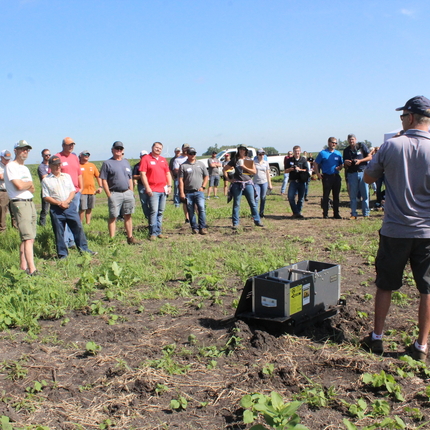By Kate Hansen, former staff member
Developed by central Iowa Watershed Management Authorities (WMA), state agencies, local governments, and collaborators, a unique approach to installing conservation practices is inspiring additional projects across Iowa and other states.
On May 16, the Center for Rural Affairs hosted the webinar “Leveraging Local Connections: The Batch and Build Method” alongside John Swanson, water resources supervisor for Polk County, Iowa.
The Batch and Build Method focuses on a single or small number of practices, and streamlines efforts to install as many as possible alongside farmers, landowners, and other stakeholders.
The idea started as a pilot program. In the summer of 2021, Swanson and collaborators installed 51 edge-of-field practices using the Batch and Build method in Polk and Dallas counties—more than doubling their original goal. In the time since that number has increased to more than 135 saturated buffers and bioreactors. Each installation plays a part in improving water quality.
During the conversation, Swanson detailed best practices that other watersheds and leaders can learn from to implement similar projects. He took special note of other WMAs interested in such projects. Swanson provides coordination services for 4 WMAs in central Iowa.
“[The WMA structure] has created a perfect platform to talk about, ‘how do we do things differently?’” Swanson said.
The best practices Swanson identified are:
- Identify barriers - money and interest may not be the most important barriers for a landowner to install a conservation practice. Time and convenience play an incredible role in someone's ability to implement conservation. Find the time and place to ask—what would it take?
- Targeting - what is the WMA or watershed’s top priority? Find a tool to map and identify key locations to target. Create a list of landowners to contact. Get organized. Improve techniques, such as surveying.
- Build a team - identify roles, such as outreach and landowner contact, surveying, designing, and project management. Keep stock of who is already working within the watershed, who is motivated, agencies, and collaborators.
- Funding - establishing a central fiscal agent brings a new level of convenience to conservation. It also improves efficiency and reduces the burden on landowners. WMAs create a great platform to explore creative funding arrangements. State and federal funding, with a local fiscal agent, leads to implementation and has equated to more projects on the ground.
- The plan - develop a plan and implementation timeline. Create an ongoing sense of urgency and excitement by setting and meeting deadlines.
- Group install - prioritizing the work of the team on a resource concern or practice type, creating a plan, conducting outreach, developing a funding mechanism, and grouping sites together is a successful method.
Swanson said all of those things can be done through a WMA platform.
“It’s the perfect place to do it,” he said. “At the end of the day, if you create demand, and you have truly good projects, the funding can come together if you think creatively.”
To learn more, see the recording below.





